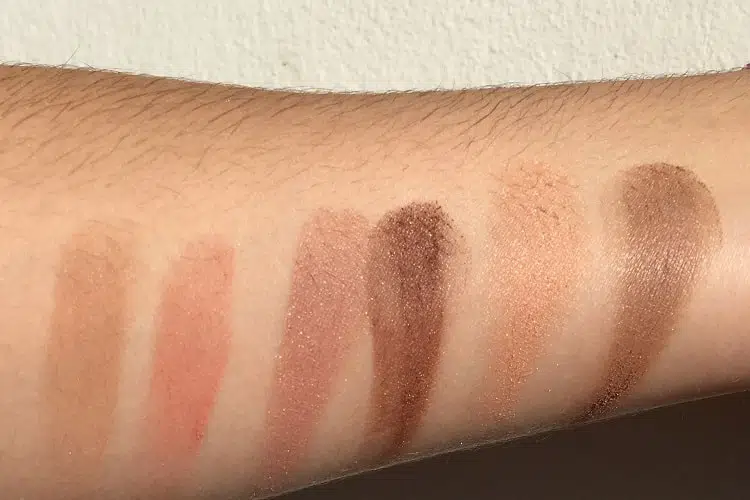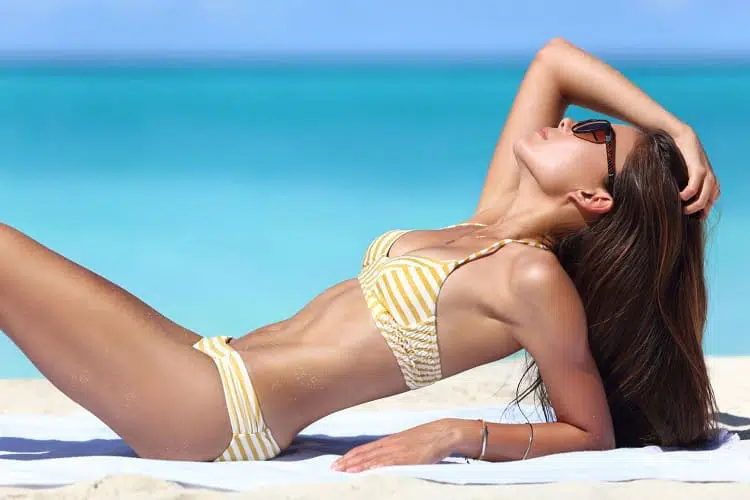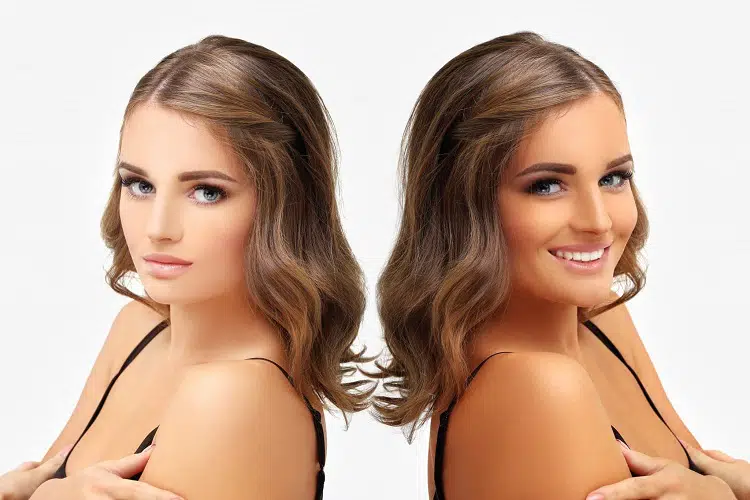
There’s nothing like the appeal of glowing, healthy skin to make you feel your best, but if you have to expose yourself to UV damage, it’s simply not worth it.
Enter bronzer, the easy solution for sun-kissed skin without the UV damage, and one simple makeup product that could be missing from your line-up.
What is bronzer used for?
Bronzer is applied to the face and parts of the body to give the appearance of healthy, warm, glowing skin. Often confused with contour and blush, bronzer is all about accentuating where the sun would naturally hit to give you a radiant and healthy complexion.
Bronzer can be a gamechanger when applied correctly and if you feel that you’re missing some warmth in your face, you’ll need to find out more.
This guide has everything a beginner needs to start their bronzer journey and achieve a naturally sun-kissed and stunning complexion.
What is Bronzer?

Bronzer is a makeup product that goes directly onto the skin and aims to create a sun-kissed or lightly tanned but natural looked.
Unlike blush, sunless tanner, and contouring the role of a bronzer is to highlight the areas where the sun would normally hit, making your complexion warmer and healthier.
Bronzers come in all shapes, sizes, colors, and forms, so if you’ve never used one before it can take some research to get it right.
The most popular bronzers today are powders, liquids, and sticks, depending on what you require from them, and there are loads of shades and finishes to choose from.
Adding a bronzer to your makeup routine can make a huge difference on your complexion and it can be worn effectively on its own or with other products like blush and foundation.
The key is knowing which color suits your skin and finding the right placement, with the application itself being pretty straightforward.
Bronzer vs Contour vs Blush

One of the biggest misconceptions about bronzer is that it can be used for contouring or in place of your blush. The truth is, bronzer is its own product that deserves a separate routine and should never be applied in the same way that you do your blush or contour.
Bronzer is all about achieving a warm, radiant glow on the face and making it look naturally sun-kissed.
Contour, on the other hand, is applied to specific areas of the face in an effort to make it look more defined, smaller, and sculpted.
The shades of contour are usually darker than blush and not designed to give the shimmery or natural look as they’re all about creating and accentuating shadows.
Blush is a different type of product altogether, used predominantly on the cheekbones to give a flush to the face.
This can be applied as a cream or powder and usually comes in shades like oranges, pinks, and reds, depending on your skin tone and what color suits your complexion.
Many people achieve a flawless look by combining bronzer, blush, and contour together, and for others, the use of all three is too dramatic.
Half of the fun of makeup is experimenting with different things to find a look that you like, with these three each offering something unique for your face.
How to Find the Right Bronzer For Your Skin

As bronzer is designed to give you a natural glow, you want to make sure it closely matches your natural skin tone. To do this, you’ll have to figure out what your primary skin tone is and what your undertones are, and with these, you can find your perfect bronzer fit.
- Fair skin: Opt for something with peach and rose colors in it as this suits people with fair to light skin.
- See the best bronzers for fair skin
- Olive skin: Those with olive skin are lucky enough to find that most colors of bronzer will work for them. The best match is something with a golden brown or copper tone to it, as it will accentuate the natural color of your skin.
- Dark skin: There’s a myth that bronzers don’t work as effectively with darker skin tones, but it’s simply not true. Women with dark skin tones will do best with browns, caramel, and orange-brown shades.
Next, you’ll need to determine your undertone, which is either cool, warm, or a combination of both.
The easiest way to tell this is by looking at the veins on your wrist and seeing what color they are. If the veins are blue or purple, this means cool undertones, and if they’re more greenish, they’re warm.
No matter your skin tone or undertone, you should never use a bronzer that’s more than two shades darker than your natural skin color. The goal is to achieve a natural but enhanced look, so stay as close to reality as possible.
The Secret to Applying Bronzer

The ultimate goal of bronzer is to get a sun-kissed look without ever stepping foot outside. This means you’ll want to focus on the areas where the sun would normally hit and apply a little bronzer to each of them.
On your face, these areas are on your temples, top of the forehead, cheekbones, chin, and on the tip of your nose.
Some people find it easier to start at the top of their head and create a numerical three that takes them all the way down to their jawline and hits the most important places.
To go even further than your face, it’s possible to apply bronzer to your collarbones and shoulders, with some even adding it to their cleavage.
If you do plan on bronzing your entire body, there are lotions and creams suited for more coverage, and that are more affordable than using a facial bronzer.
Top Tips for Bronzer Perfection

Applying a flawless bronzer is about more than just knowing the sweet spots to hit. Before you jump in and give the bronzer trend a try, make sure you’re equipped with the right tools and enough know-how to do it right.
- If applying wet or liquid types of bronzer, a makeup sponger or your fingers can be all you need to do it.
- Creamy bronzer products work best with a synthetic brush as it doesn’t hold onto it, letting it stick to your face instead.
- Powdered bronzers should be applied with a natural brush rather than a synthetic, as the powder will leave the brush more effectively.
- Make sure you blend your bronzer in when you’re finished with your makeup otherwise it won’t have the natural sun-kissed look that you’re after.
- A brush with a round head is best for matte and sheer bronzers, but an angled brush works best for shimmery finishes.
- Only ever tap into the bronzer with your brush and don’t dip it, being sure to tap off any excess powder before applying it to your face.
- Soft and gentle circular strokes will give you a gentle look that you can build upon, rather than doing too much too soon.
Bronzed and Beautiful
All skin types and tones can benefit from a healthy application of bronzer and it offers so much more than just contouring or blush can do on their own.
Spend some time experimenting with all of the bronzer tones and figuring out which color works best for you and then see the difference it can make to your complexion.
Related Questions
Bronzer is the easiest way to add some healthy color to your face and achieve a warm glow that’s usually only possible by tanning in the sun.
If you’re still not convinced that bronzer will work for you, read on for some FAQs about the beauty product that can give you a push in the right direction.
Can I Use Bronzer Without Foundation?
Yes, it’s possible to apply bronzer even if you’re not wearing foundation or any other makeup underneath, giving you a more natural appearance.
Apply the bronzer to the usual areas where the sun would naturally hit and you’ll still benefit from the warm glow that it gives.
Can You Put Bronzer on Your Whole Face?
Bronzer is not designed for full face coverage but rather to highlight specific points of the face to make it look as if you’ve got a natural, glowing suntan.
You should avoid covering your face with bronzer but use a loose powder or BB cream instead if you want lighter coverage.
Can I Wear Bronzer On My Legs?
Some people like the look that bronzer gives their legs when it’s gently brushed on, but there may be easier and cheaper ways to get the sun-kissed effect on your whole body.
Use a sunless tanner or tinted body moisturizer to cover your arms, legs, and other areas without having to apply bronzer to the whole area.